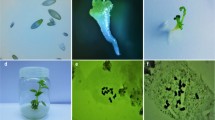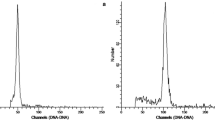Summary
Rice nodal segments from three flowering haploids were excised and treated for different lengths of time with 0.3% or 0.4% colchicine (dissolved in 2% DMSO) in an attempt to induce fertile seeds. A combination of higher colchicine concentration and longer hours of treatment reduced the survival rate of treated segments, but more fertile plants were transformed. Pooled data showed that of the 842 segments used, 42.2% survived the treatment and sprouted, but only 31.9% were successfully established and grown to maturity. Among the 269 mature plants, 29,4% produced fertile seeds (panicles) with an average of 146.2 seeds per diploidized plant.
Similar content being viewed by others
References
Anonymous (1983) Breeding for diseases and insect resistance in japonica rices. Taiwan Agric Res Inst 1983 Annu Rep, pp 3–11
Chen CC, Lin MH (1976) Induction of rice plantlets from anther culture. Bot Bull Acad Sin 17:18–24
Chen CC, Chiu WL, Yu LJ, Ren SS, Yu WJ (1983) Genetic analysis of anther-derived plants of rice: independent assortment of unlinked genes. Can J Genet Cytol 25:324–328
Lee J, Chen CC (1982) Genetic and histological evidence for microspore origin of anther-derived plants of rice. Taiwania 27:86–92
Lin MH (1979) Diploidization of haploid rice plants by colchicine treatment. J Agric Res China 28 (1):45–49
Oono K (1981) In vitro methods applied to rice. In: Thorpe TA (ed) Plant tissue culture, methods and application in agriculture. Academic Press, New York, pp 273–298
Thiebaut J, Kasha KJ, Tsai A (1978) Influence of plant development stage, temperature, and plant hormones on chromosome doubling of barley haploids using colchicine. Can J Bot 57:480–483
Wong CK, Hsieh SY, Chang ST, Woo SC (1987) Rapid clonal propagation in rice via nodal segment. Bot Bull Acad Sin 28:25–32
Yoshida S, Forno DA, Cook JH, Gomez KA (1976) Routine procedures for growing rice plants in culture solution. In: Yoshida S, Forno DA, Cook JH, Gomez KA (eds) Laboratory manual for physiological studies of rice. IRRI, Philippines, pp 61–66
Author information
Authors and Affiliations
Additional information
Communicated by G. Wenzel
Rights and permissions
About this article
Cite this article
Wong, C.K. A new approach to chromosome doubling for haploid rice plants. Theoret. Appl. Genetics 77, 149–151 (1989). https://doi.org/10.1007/BF00292330
Received:
Accepted:
Issue Date:
DOI: https://doi.org/10.1007/BF00292330




